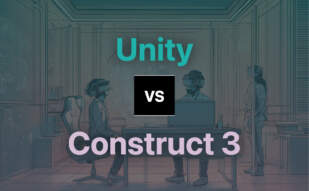Construct 3, developed by Scirra Ltd, is an HTML5-based 2D video game engine known for its visual programming approach through ‘event sheets’, enabling efficient game creation for both beginners and professionals.

For those exploring alternatives to Construct 3, other options to consider are GameMaker, Unreal Engine, Godot, GDevelop, Unity, RPG Maker, Android Studio, jMonkeyEngine, LibGDX, O3DE, Pygame, SpriteKit, and Love2D.
Construct

Leaping onto the tech frontier, Construct also known as Scirra Ltd, introduces a revolutionary way to develop video games. It’s a versatile HTML5-based 2D game engine catering largely to non-programmers, and designed for the swift production of video games through its unique visual programming feature.
Construct Top Features
- Event Sheets – Construct uses ‘event sheets’, akin to the fundamental source files employed in traditional programming languages. These sheets store an array of events, each with conditional expressions or triggers.
- Compatibility – Characterized by an expansive compatibility range, Construct supports both native and web-based applications, and can export to a diverse range of desktop and mobile browsers, as well as consoles like Wiley U system and Xbox.
- JavaScript Support – Construct incorporated JavaScript as a scripting language in May 2019, placing another feather in its cap.
- Enhancements in Construct 3 – Offering more than its predecessor, Construct 3, disclosed in 2015, includes support for Mac, Linux, various languages, and presents an official plug-in SDK for the editor.
- Free Programming – Empowering imagination and taking the game development scene by storm, Construct 3 introduced ‘Free Programming’, a feature with boundless possibilities.
| Feature | Description |
|---|---|
| Hub | Ensuring comprehension and mastery, this includes checkpoints and tests after each learning phase. |
| Construct Arcade | Launched in 2011, this is a dedicated game portal for showcasing projects developed using Construct 2 and 3. |
| Construct Animate | A fresh animation tool hinged on Construct 3, made available to the public in beta in May 2022. |
Construct Downsides
- Changes – Over the years, Construct has altered its Application Programming Interface (API) technology and its plugin Software Development Kit (SDK), which may pose adaptation challenges.
- Subscription Model – Moving away from a pay-once model, Construct shifted to a subscription-based model as it morphed into a web application, which may not appeal to all user preferences.
Construct Pricing
Construct’s pricing follows a subscription-based model, offering flexibility and continuous updates.
Construct Use Cases
Use case 1 – Novice Game Developers
With an aim to cater to non-programmers, Construct offers an intuitive and user-friendly interface, with its novel ‘event sheet’ programming allowing swift creation of games, making it ideal for beginners.
Use case 2 – Experienced Game Developers
Offering robust compatibility across various platforms and supporting intricate features like animation, JavaScript scripting, and free programming, Construct is a powerful tool for experienced developers too.
Use case 3 – Educators
With features like ‘Hub’ providing checkpoints and tests to ensure understanding and learning, Construct can serve as a valuable resource for educators in game development and programming.
GameMaker
Meet GameMaker, a renowned two-dimensional game engine, simplifying game design while ensuring scalability and functionality. Recognized by experienced developers in the industry, GameMaker has been instrumental in creating popular games such as Undertale, Forager, and Chicory: A Colorful Tale.
GameMaker Top Features
- Simplicity: GameMaker offers easy-to-use tools making game development accessible even to beginners.
- Scalability: The engine can handle projects of varying complexity, from novice to professional levels.
- Code Editor Support: Language Server for Syntax Highlighting and Intellisense support allows for the integration of different languages.
- Modding Capabilities: The anticipated updates in 2023 will enhance modding capabilities, opening up new potentials for developers.
- Integration of AI: In collaboration with OpenAI, GameMaker aims to further simplify the game-making process.
| Feature | Description |
|---|---|
| Mod.io Extension | Eases the addition of user-generated content to your game. |
| Community Development | Emphasizes game developer support and community development. |
GameMaker Limitations
- Limited to 2D game development.
- While the engine is beginner-friendly, mastering advanced features can be challenging for newcomers.
GameMaker Pricing
GameMaker offers different pricing tiers – Free, Creator for game development careers on desktop stores, Indie for game releases with multiple export options, and Enterprise for studio releases on major consoles.
GameMaker Use Cases
Use case 1 – Beginner Game Developers
With a user-friendly interface and simplicity, GameMaker is an excellent platform for beginners venturing into the game development industry.
Use case 2 – Professional Developers
For professionals, GameMaker’s robust toolkit and scalability make it a top choice for larger-scale game development projects.
Use case 3 – Indie Game Designers
With its rich history of facilitating the creation of popular indie games, GameMaker is ideal for independent game designers striving for creativity and uniqueness.
O3DE
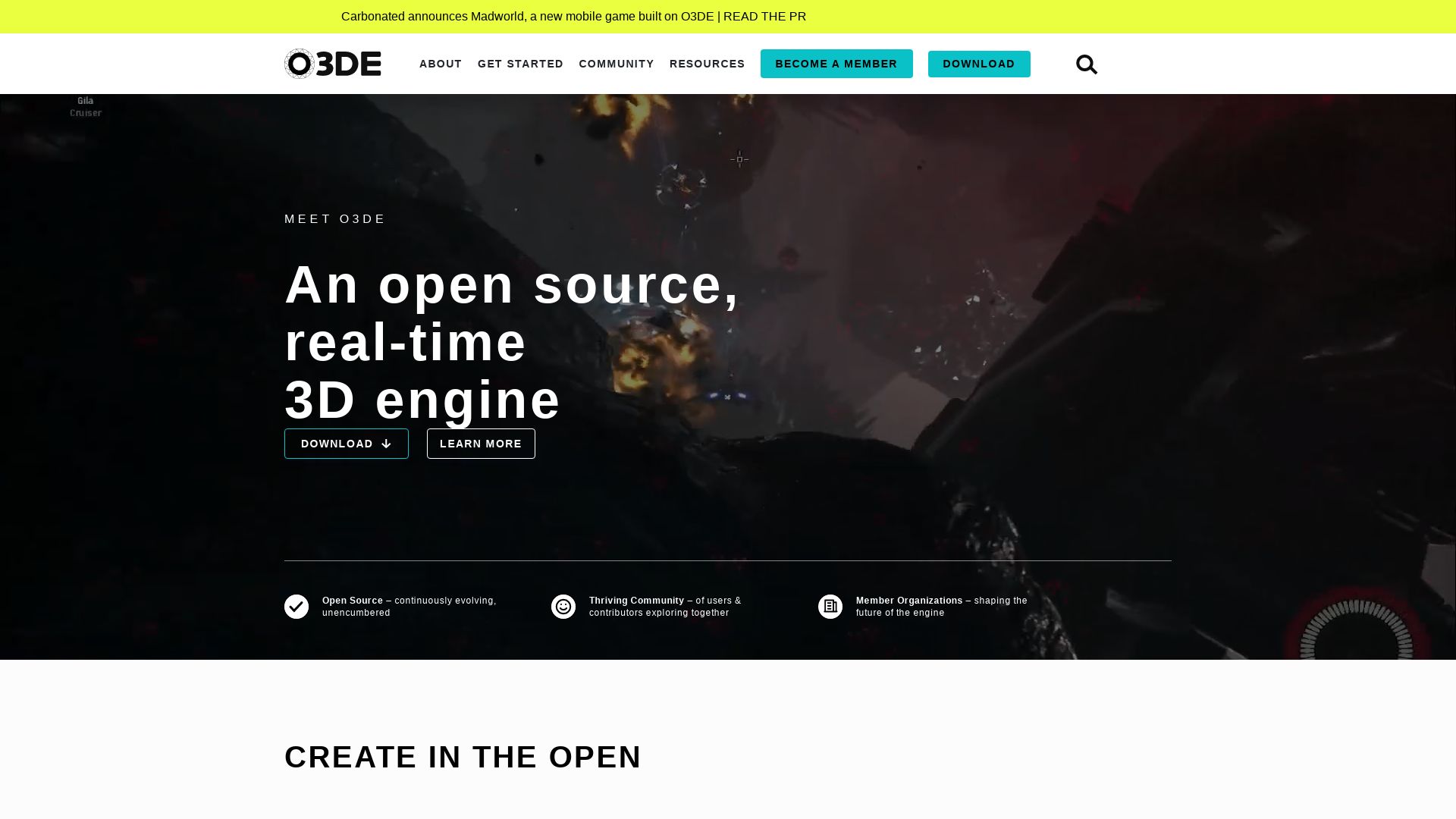
Stepping into the world of advanced game development, we introduce O3DE – the Open 3D Engine. Constructed by the alliance of globally recognized technology giants such as AWS, Epic Games, and Microsoft, the O3DE provides an open-source platform to build high performance, interactive experiences and complex simulations. Born as an evolution of Amazon Lumberyard, this powerful engine finds its application in the construction of stunning 3D assets and advanced game development.
O3DE Top Features
- Modular Engine and Components- Composed of Gems, O3DE is built with libraries having standard interfaces providing flexibility in adding and removing components without recompiling O3DE.
- Advanced Scripting- Supports high-level languages such as C++, Lua, and Python alongside Script Canvas for runtime logic, offering developers unparalleled flexibility.
- Networking Capabilities- Ensures seamless online multiplayer experiences.
- Multi-GPU Support- The new release brings a framework for multi-GPU support taking performance to the next level.
| Performance Improvements | Supported Platforms |
|---|---|
| New features, workflow enhancements, and visual improvements | Windows, Linux, iOS, and Android |
| Better memory support, mesh instancing, and raytracing reflections improvement | Advanced extension languages: C++, GDScript, C#, and Unity’s C# |
O3DE Limitations
- Limited system requirements- Requires Windows 10 1809 or higher, or Ubuntu 20.04 or higher.
- Past Performance- Lumberyard-based New World game received middling reviews.
O3DE Pricing
O3DE stands as a fully open-source, royalty-free solution committed to fostering innovation in game development.
O3DE Use Cases
Use case 1 – Advanced 3D Game Development
With support for highly advanced tools and a modular construction, O3DE aids developers in creating rich and complex 3D games with ease and efficiency.
Use case 2 – Interactive Experiences
Whether it’s architectural visualizations, training simulations, or interactive experiences, O3DE’s high performance and vast toolkit make it a strong choice in diverse domains.
Use Case 3 – Simulations
With its advanced physics simulation and animation capabilities, O3DE is apt for those looking to construct detailed and intricate simulations.
Pygame

Meet Pygame, a set of Python modules designed for creating video games that debuted in 2000. Offering cross-platform capabilities, it simplifies real-time game development, making it more accessible for beginners and advantageous for veterans.
Pygame Top Features
- Cross-Platform Capability: Pygame is compatible with nearly every operating system, including Android devices.
- Community-Driven: With numerous community-created tutorials, Pygame encourages user involvement in its development.
- Wide Support: Pygame offers support for vector math, collision detection, 2D sprite scene graph management, MIDI support, pixel-array manipulation, transformations, and more.
- Portability: Pygame can be utilized on handheld devices, game consoles, and even OLPC computers.
- Efficiency: Pygame code is quicker (10-20 times faster than regular Python code) and supports Assembly Language, which is 100x faster than Python code.
| Feature | Details |
|---|---|
| Background Scrolling Speed | Allows adjustment for gameplay pace. |
| Increased FPS | Grants control over the game’s speed, slowing down or speeding up gameplay. |
| Game Display Definition | Defines its game display with display.set_mode(). |
Pygame Limitations
- Being an open-source tool, there might be fewer dedicated support resources than commercial engines.
- It may take more time to create complex games, due to the need for coding.
Pygame Pricing
As an open-source project, Pygame is free to use under the GNU Lesser General Public License.
Pygame Use Cases
Use case 1: Education
Pygame’s simplicity makes it a valuable tool in teaching Python programming to young kids, college students, and first-time programmers.
Use case 2: Game Development
Developers can leverage the extensive feature set of Pygame to create a variety of games, from open-source to commercial ventures.
Use case 3: Cross-platform Development
With its broad compatibility, developers can create games that are playable on a variety of platforms, from handheld devices to game consoles.
SpriteKit
![]()
Embarking on a gaming development journey? Look no further than SpriteKit, a compelling game development framework, tailored for iOS and macOS. With an emphasis on creating interactive 2D games, SpriteKit seamlessly weds animated graphics with physics-based gameplay and cross-platform capabilities.
SpriteKit Top Features
- Constructed over SceneKit framework: Leverages a robust architecture for creating and animating 2D game objects.
- Employs Box2D physics engine: Ensures realistic object interactions, enhancing the user gaming experience.
- Swift language support: Enhances code efficiency and offers an ample library of SwiftUI and Swift code samples for simplified game creation.
- Comprehensive Game development tools: Equipped with features like scene editing, animation, physics, and particle systems, SpriteKit is your all-in-one game development environ.
| Components | Functionality |
|---|---|
| Scene | Forms the foundational unit in SpriteKit game development |
| Node | Creates visual elements in the game |
| Sprite | Offers 2D bitmap images to be used as game characters or backgrounds |
| Action | Defines sequence of tasks that sprite nodes execute |
SpriteKit Limitations
- Development restricted to Apple ecosystem: This curtails the cross-platform potentials.
- Trade-offs: Performance optimization may compromise collision accuracy, and vice-versa.
- Learning Curve: Requires proficiency in Swift and familiarity with iOS development to quicken mastery.
SpriteKit Pricing
Advantageously, SpriteKit is a part of the Apple Developer program, hence, it is free of cost and seamlessly available on all Apple devices.
SpriteKit Use Cases
Use case 1
If your target audience is majorly iOS users, SpriteKit serves as an ideal Game Development Engine. With its native association with iOS, it splendidly leverages the device capabilities and offers an optimized gaming experience.
Use case 2
For aspiring game developers wishing to build 2D games, SpriteKit presents an all-inclusive development environment, enhancing your creative journey with practical capabilities.
Use Case 3
Are you a Swift developer? Master SpriteKit for an added advantage in your career path. As SpriteKit primarily employs Swift for game development, it could open doors to a plethora of opportunities.
Love2D
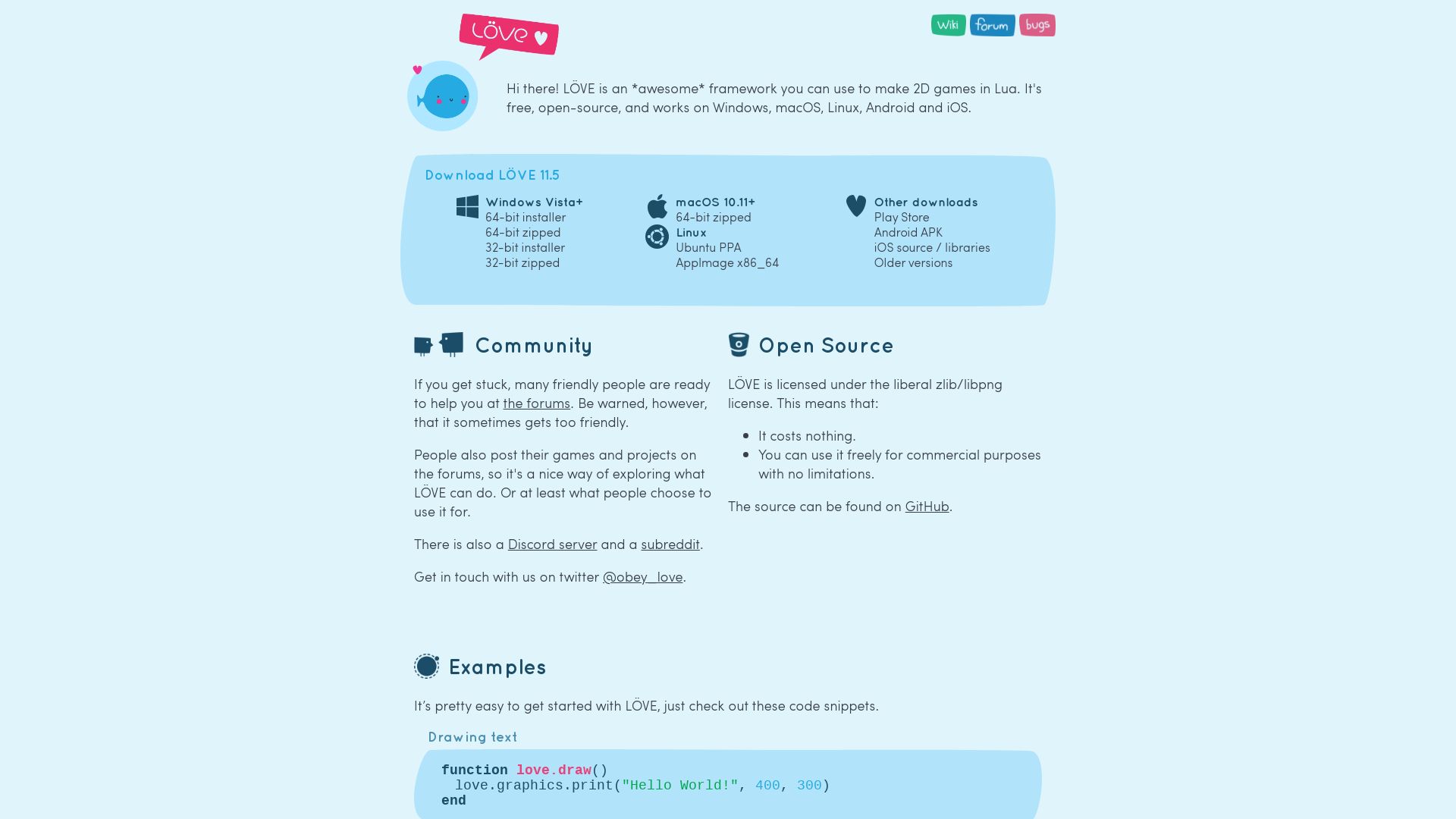
Incepted in the realms of digital expression on January 13, 2008, Love2D has been nurturing creation in the gaming universe as a free, open-source game framework, principally written in C++. Indulge in the domain of 2D game development with Love2D, where liberty meets creativity.
Love2D Top Features
- Extraordinary compatibility: Encompasses platforms as varied as FreeBSD, OpenBSD to Android and iOS, reaching out to diverse and potential game developers around the globe.
- Rich media support: Sweeping access across video, sound functions and supports mainstream image and audio formats.
- Lua scripting language: A high-level programming language known for its simplicity and flexibility, setting foot in game development is a less daunting task.
- Impressive library support: Libraries like SDL, OpenGL, and the LuaSocket library for network communications amplify game-play and interactivity.
- Arismatic pixel display: The unique feature of Love2D that supports OpenGL pixel shaders GLSL which sums up its realistic gaming imagery.
| Feature | Benefit |
|---|---|
| Physics engine Box2D | Creates realistic motion and actions in the game |
| Portable network communications | Develop multi-player games or applications that communicate over the network |
| Libraries like Simple Tiled Implementation and anim8 | Makes game development process efficient |
Love2D Limitations
- While it’s a brilliant tool for 2D games, it may lack the power and complexity of Unreal and Unity for something larger and 3D.
- With the limitation of modules and the absence of a graphical user interface, the framework might be a tad bit limited for experienced game devs.
- Cross-platform games working between different LÖVE versions have no strict guarantee.
Love2D Pricing
Exploring Love2D comes at no cost. It embraces the open-source spirit, making it accessible to game enthusiasts and developers irregardless of their budget constraints.
Love2D Use Cases
Use case 1
Aspiring developers and enthusiasts can utilize Love2D for mastering Lua scripting and the basics of game development, filling up their arsenal for more sophisticated pursuits.
Use case 2
Established game developers can adapt Love2D for rapid prototyping, creating, testing, and refining game mechanics before shifting to a more powerful engine when the basic design is solid.
Use case 3
Love2D with its portable network support can be used by educators teaching programming concepts, facilitating an engaging environment.
Unreal Engine
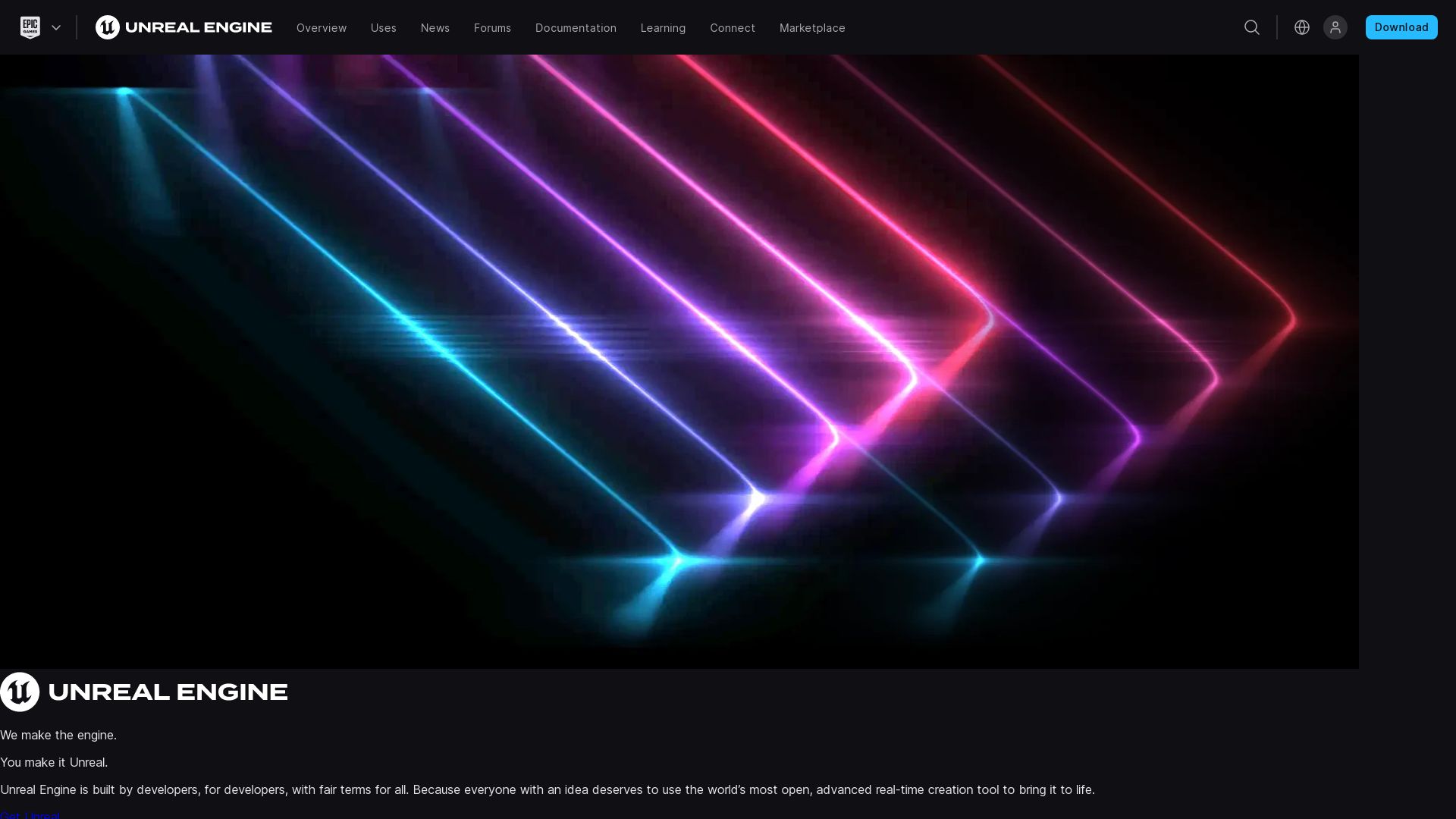
Stepping into the realm of game development engines, we encounter Unreal Engine (UE). First showcased in 1998 with the game ‘Unreal’, the engine was developed by Epic Games. Spanning various game genres and industries, UE transcends from the digital pages of first-person shooters on PCs to the cinematic canvases of film and television.
Unreal Engine: Top Features
- Written in C++, the engine optimizes versatility as it supports an array of platforms, moving freely from desktop or mobile to consoles and even virtual reality platforms.
- To stimulate creativity, UE incorporates UnrealEd, a level editor that supports real-time constructive solid geometry operations.
- For the budding game developers, UE allows a democratic pathway with its Unreal Development Kit (UDK). This free version of UE3’s SDK was released in November 2009, creating avenues for iOS games and apps.
- In a move towards increased transparency, UE4 was made available for free to all users in March 2015, birthing a pathway for games like ‘Daylight’.
- Facilitating a rich community of creators, Unreal Engine Marketplace offers a stage for developers to both sell their creations and purchase the work of other developers.
| Feature | Impact |
|---|---|
| Acquired Features from Quixel | Enhances details and offers photorealistic quality |
| Basic Project Templates | Serves as a starting point for first-person or third-person gaming experiences. |
Unreal Engine: Limitations
- Though UE initiated a free model, a 5% royalty fee applies for products that make more than $3,000 per quarter.
- The waiver of this royalty fee is limited to games published on the Epic Games Store, thus reducing the scope for income.
Unreal Engine Pricing
Epic Games implements a pricing model where it charges 5% of revenues over USD 1 million for commercial usage of UE. However, for educational institutions, Unreal Engine is offered for free.
Unreal Engine Use Cases
Use case 1: Game Development
With its expansive range of features, Unreal Engine serves as a powerful tool for game developers, facilitating the creation of both first-person and third-person gaming experiences.
Use case 2: Modding
Through its welcoming attitude to modders, UE has given rise to a diverse collection of modded games, expanding its footprint further in the gaming industry.
Use case 3: Educational Institutions
With its free availability to schools and universities, Unreal Engine is playing a key role in shaping the future generation of game developers.
Godot
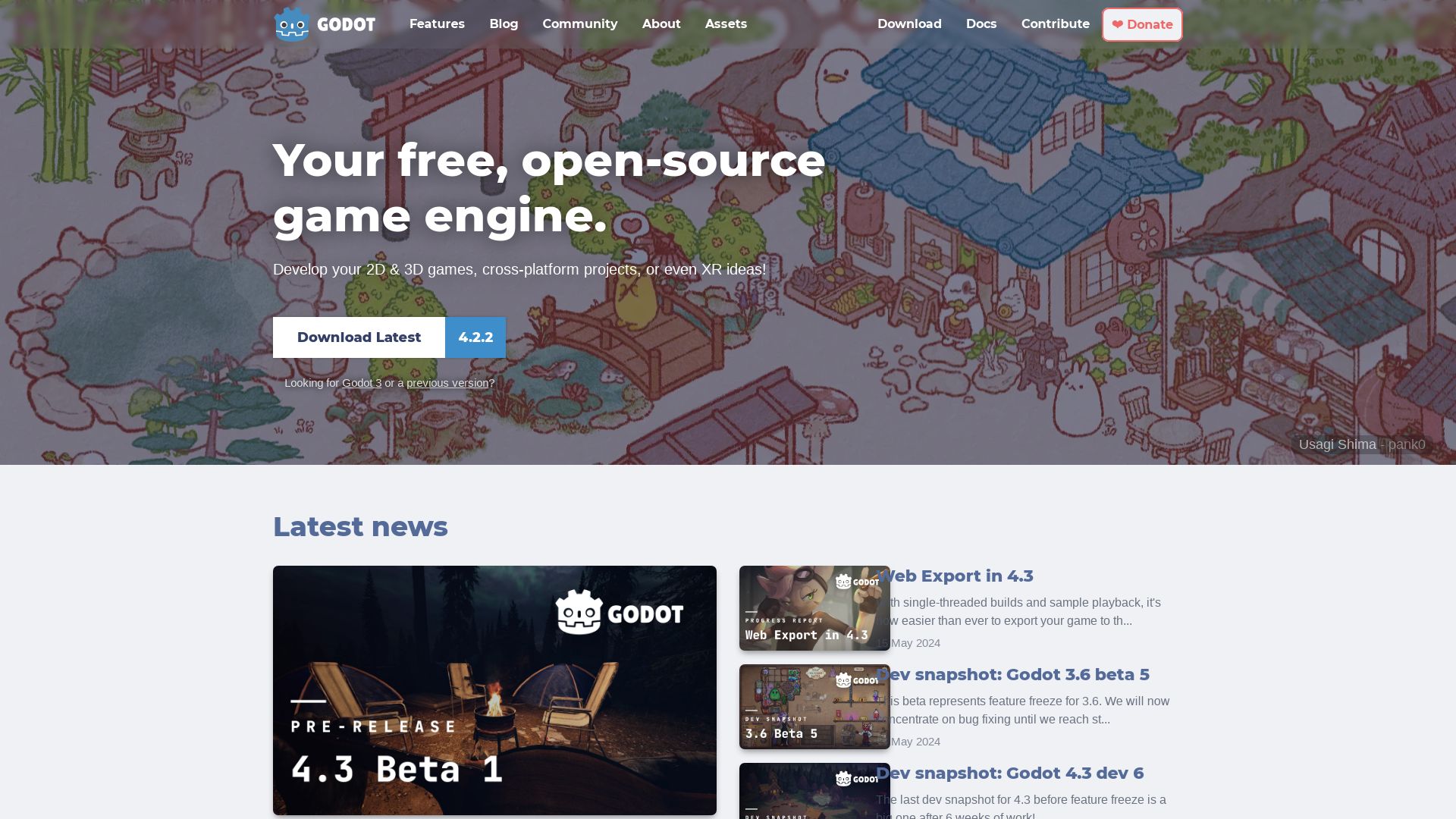
Meet Godot, an open-source game engine acclaimed globally by developers. Emphasizing a distinct scene-driven design, it offers game creation from simple blocks and employs nodes to engineer complex, reusable scenes.
Godot Top Features
- Intuitive scene-driven design: Enables the creation of games from simple blocks, scaffolded into complex, reusable scenes.
- GDScript: Built-in scripting language offering streamlined game logic with optional static typing.
- Vast language support: Besides the official C++ support with GDExtension API in 4.0, it supports C# for .NET platform. Additional language bindings like Rust, Nim, Python are available through community contribution.
- Flexibility: 3D engine compatible with high and low-end devices.
- Direct import of Blender files: Allows seamless integration in the game development process.
| Feature | Benefit |
|---|---|
| 2D workflow | Specialised for creating 2D games and apps, providing distinct artistry. |
| Free and Open Source | Fall under MIT license, with an open-source and modifiable codebase for developer flexibility. |
| Signals | Facilitates communication between nodes, enhancing the overall game mechanism. |
Godot Limitations
- Lacks suitability for complex 3D game development.
- .NET platform support is limited to desktop platforms in Godot 4.
Godot Pricing
Godot commands an incredible appeal among developers looking for cost-effectiveness. It is absolutely free and has no hidden fees. Under the MIT license, it is an open-source entity with an entirely modifiable codebase.
Godot Use Cases
Use Case 1: Beginners in game development
With its intuitive design and visual editor built into the engine, Godot is an ideal place to start for budding game devs. The ease of use and comprehensible mechanism eases the learning curve dramatically.
Use Case 2: Experienced game developers
With robust features, powerful engine, and immense customization, Godot is a platform loved by experienced developers. Its language support, and capacity to create high-quality 2D and 3D games makes it a strong contender.
Use Case 3: Collaborative Development Teams
Godot’s integrated storage solution is tailor-made for team collaboration. It allows for easy sharing & synchronization, making it perfect for a development studio setup.
GDevelop

If you’ve been traveling the game creation universe in search of a development star, meet GDevelop. An open-source, cross-platform brainchild of a Google software engineer, it’s a game-making genie for non-programmers as well as experienced coders. It’s as versatile as an accordion, happy to perform on Windows, macOS, Linux or even hum in a web browser and serve up games on PC, Web, and Mobile platforms.
GDevelop Top Features
- Visual Programming: Allows distance learners to coding gurus to wave their hands and command logic.
- Advanced 3D Graphics: Consider this the digital Picasso for your polygons and pixels.
- Platform Compatibility: As flexible as gymnast, works on Windows, macOS, Linux and web browsers.
- Event-Based System: Your game logic built using an intuitive, powerful tool that reports back like a seasoned news anchor.
| Key Features | Benefits |
|---|---|
| Physics-Based Movement | Adds a dash of reality to your alternate universe. |
| Pathfinding functionality | Never lose your way in the game labyrinth! |
| Extension options for functionality | Like a tailored suit, fit your game engine to your unique requirements. |
GDevelop Limitations
- For the advanced users seeking freedom, you might stumble upon slower development and less stability. So, trade-off alert!
GDevelop Pricing
Love free lunches? GDevelop is completely free while its cousin Construct 3 tags a license fee for its company. Plus, you can add ‘monetizable games’ to your resume.
GDevelop Use Cases
Use Case 1: Game Design Education
Whether you are a student wishing to learn game design tools techniques, or an educator, GDevelop is a dynamic canvas to your gaming dreams. It introduces you to a variety of fundamental concepts like coordinate planes and coding logic.
Use Case 2: Building Your Game
Want to walk on the path of creating your own game? Step right in! GDevelop takes your hand, introducing you to facets essential for crafting that blockbuster game – project planning, testing, and UI + UX understanding.
Use Case 3: Publishing Success
Ta-da! Your game is now ready to be published, and you know exactly which platforms to leverage – Android, iOS, Facebook Gaming, Steam. GDevelop ensures you exit the stage, mic dropping.
Unity

Launching back in 2005, Unity has carved its niche as a powerful engine for both 3D and 2D game development. Its adaptability across operating systems and cross-compatibility for Android and iOS have set this platform apart in the gaming sphere.
Unity Top Features
- Platform Compatibility: Unity boasts compatibility with several operating systems, permitting developers to create everything from augmented reality to 3D simulations.
- Render Tech and Tools: The platform provides a suite of tools, rendering technology, and features to support the creation of high-quality games.
- Rich Asset Store: The integrated asset store provides pre-designed textures and features, sparking creativity in game design.
- Coding Flexibility: Unity 3D supports multiple coding languages including BOO script, Javascript, and C#.
| Feature | Details |
|---|---|
| Developer Community | With an active community, Unity offers a collaborative environment for problem-solving and feedback. |
| Continuous Tech Evolution | Unity consistently upgrades its tech to enhance user-friendliness, compatibility, and immersive visual experiences. |
| Mobile and AR/VR Game Development | Unity encourages the creation of mobile games and fuels innovation through supporting AR/VR features. |
Unity Limitations
- Pricing Shifts: Developers have been wary of sudden pricing models changes which could impact their financial sustainability.
- Per-Install Fees: The prospect of paying a fee each time a Unity-based game is installed has sparked backlash, especially amongst solo and indie mobile developers.
- Trust Issues: Unannounced changes have fostered mistrust between Unity and its users.
Unity Pricing
The pricing structure has developers paying a per-install fee under the new model which will be effective from January 1, 2024. However, the company assures developers they will only be liable for an install fee after their game garners $200,000 in revenue and surpasses 200,000 installations.
Unity Use Cases
Use case 1 – Indie Game Developers
For independent developers weaving together innovative 2D or 3D games, Unity is a potent partner. The combination of diverse coding languages, a vibrant developer community, and an extensive asset store amplifies their creative and technical potential.
Use case 2 – AR/VR Applications
Unity’s broad operating system compatibility and commitment to tech evolution make it an ideal platform for those venturing into the AR/VR space. Whether it’s to craft immersive games or simulations, Unity provides a comprehensive toolkit.
Use case 3 – Mobile Game Developers
With its support for Android and iOS cross-platform games, Unity equips mobile game developers with robust features to create visually compelling and feature-rich games.
RPG Maker
Developed by ASCII, Enterbrain, Agetec, Degica, Gotcha Gotcha Games, RPG Maker is an acclaimed gaming engine known for its simplicity and flexibility. Released on December 17, 1992, it’s equipped with a multi-language interface, primarily designed for developing RPGs with a heavy emphasis on story-driven elements.
RPG Maker Top Features
- Easy-to-use interface: Its latest version, RPG Maker MV, offers a user-friendly experience that doesn’t demand coding knowledge.
- Versatile Character Creation: RPG Maker provides robust character creation options, enabling developers to customize their games.
- Wide Platform Compatibility: It supports a broad range of platforms including Windows, Mac, Xbox One, Nintendo Switch, Linux, Playstation and more.
- Community Support: RPG Maker’s community provides extensive support and shares modifications that enhance the game development process.
| RPG Maker Versions | RPG Maker MV, RPG Maker MZ |
| Language Support | Japanese, Chinese, Korean, English |
| Plugin Availability | Free and Paid Plugins Available |
RPG Maker Limitations
- Engine Limitations: Despite its flexibility, RPG Maker comes with certain design limitations that challenge developers.
- Reliance on Skilled Developer: This tool requires a skilled developer to avoid problematic game development.
- Controversial Titles: Games like “Super Columbine Massacre RPG!” and “Heartbeat”, developed on RPG Maker, have created controversy.
RPG Maker Pricing
RPG Maker offers over 200 DLCs available for RPG Maker MV, generally priced between $5-$25. It also implements different (mostly) free plugins.
RPG Maker Use Cases
Use Case 1: Beginner Developers
With its intuitive interface and no need for coding knowledge, RPG Maker is well-suited for beginner developers seeking to gain experience.
Use Case 2: Story-Driven RPG Development
RPG Maker’s design makes it an excellent choice for developers seeking to focus on creating ambitious, story-driven RPG games.
Use Case 3: Economical Game Development
With its affordable DLCs and free plugins, RPG Maker is a budget-friendly option for independent developers or small studios.
Android Studio
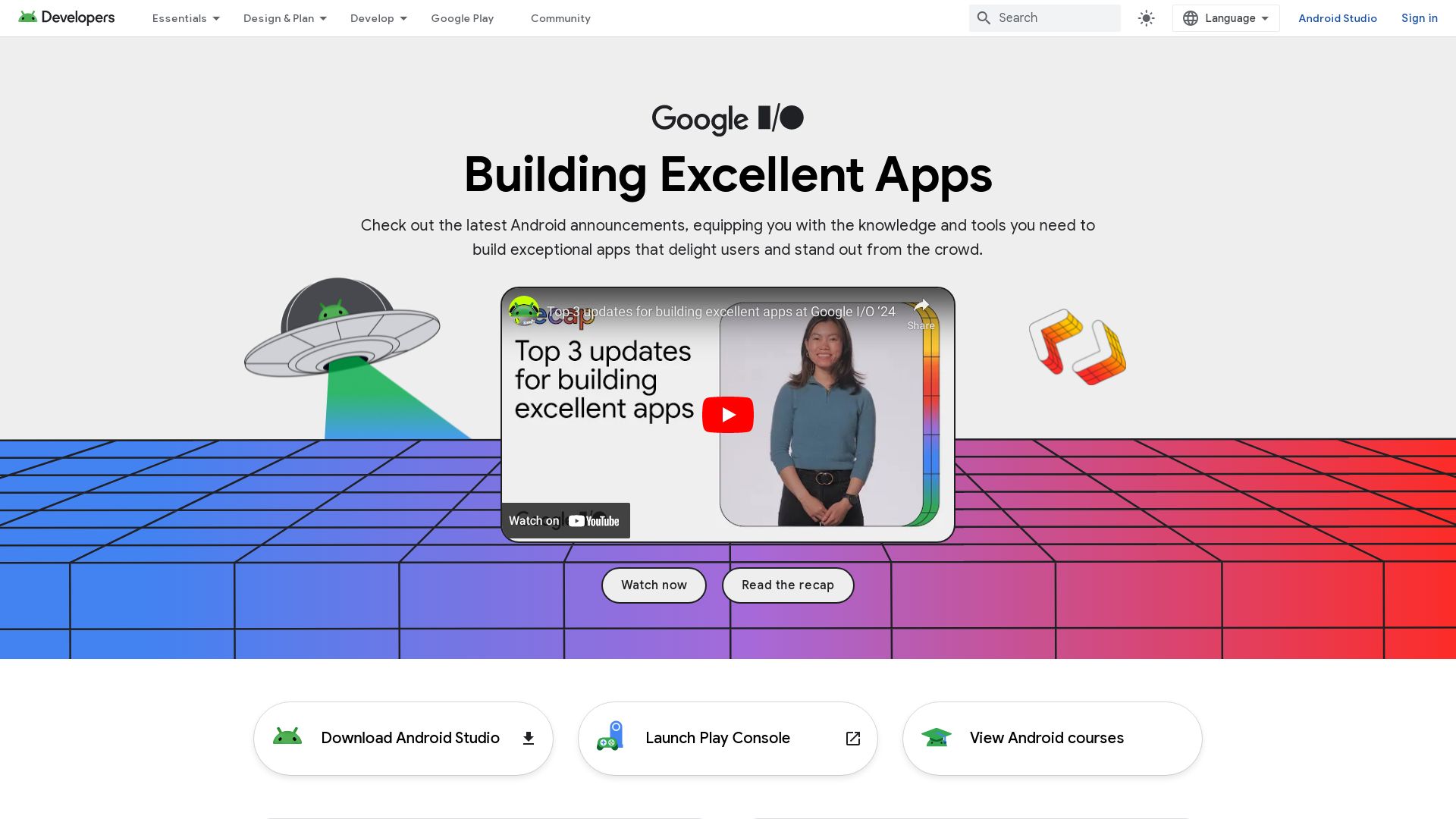
Step into the whimsical world of Android Studio, the official IDE for Android app development, laden with bells and whistles for all you tech aficionados.
Android Studio Top Features
- A seamless integration with IntelliJ IDEA code editor and developer tools to make you the Mozart of Android app development.
- A speedy little emulator that would make even The Flash envious, and alters composites in emulators and physical devices in real-time.
- It throws a red carpet for GitHub with code templates and import features that would make any coder jump for joy.
- You say C++, I say NDK. Android Studio isn’t picky, it supports both, even with built-in support for Google Cloud Platform.
- Feel like Neil Armstrong with resource and code reuse across source sets, exploring new horizons with your coding skills.
| foo | bar |
| foo | Bar |
| foo | bar |
Android Studio Disadvantages
- Requires 8GB RAM and 8GB disk space, giving a new twist to ‘Size Matters’.
- Sticks to Kotlin, making you bid adieu to your favorite Java for Android app development.
Android Studio Pricing
Good news folks! Android Studio is indeed free, perfect for both pocket-watch keepers and billionaire coders.
Android Studio Use Cases
Use case 1
For the problem solvers out there, Android Studio offers deep static code analysis to create high-quality apps that would make Sherlock Holmes proud.
Use case 2
For the perfectionists, it presents in-line debugging and memory usage profiling to track and analyze performance, making your app as sleek as a Ferrari.
Use case 3
Love making UI as much as Picasso loved painting? You’ll enjoy the GUI for developing apps with various resolutions. Making beautiful apps has never been so much fun!
jMonkeyEngine
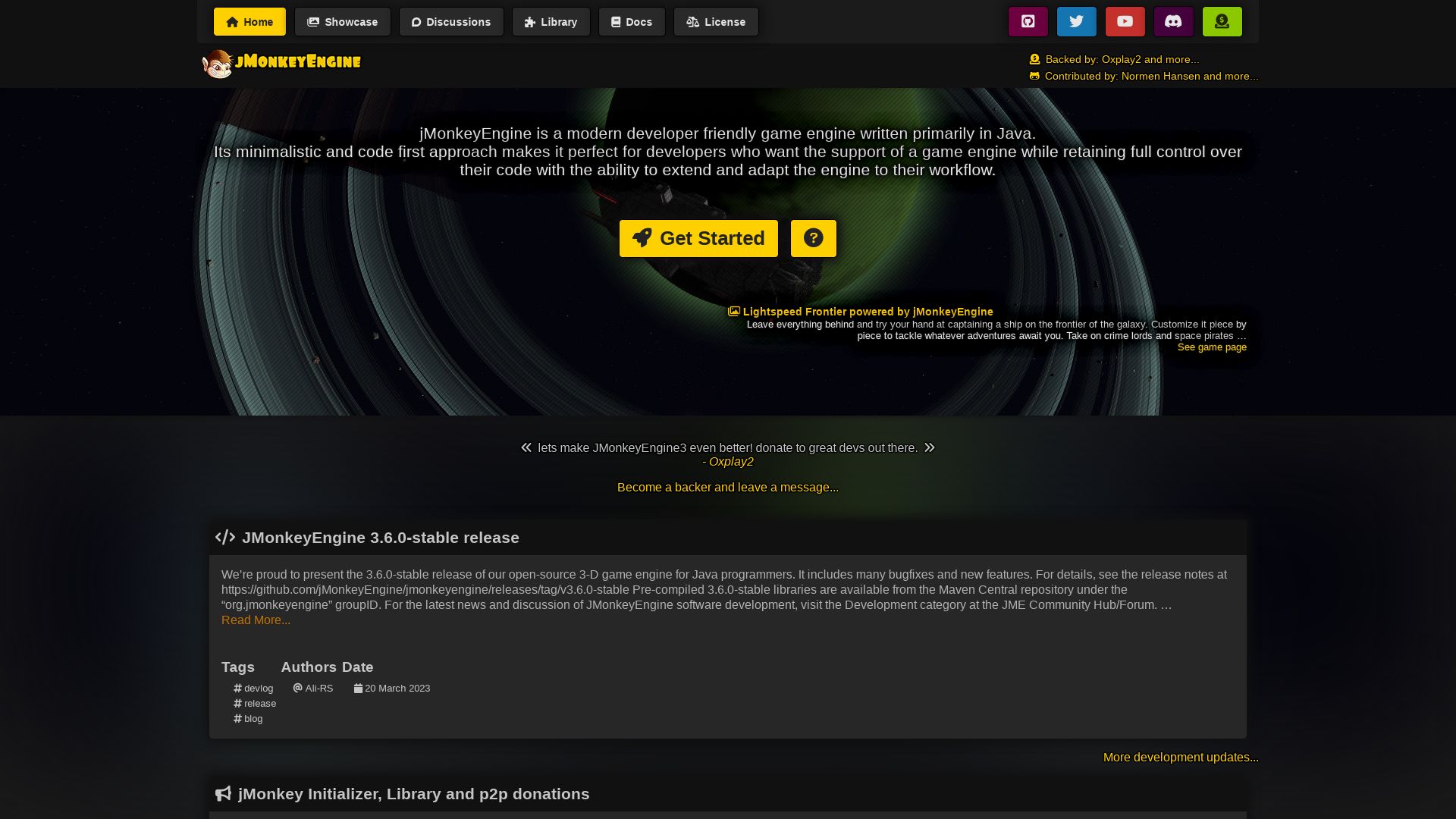
Meet jMonkeyEngine, an impressive, open-source 3D game engine for Java programmers that blends versatility with user-friendly design. Its Java-based, Android-capable nature is a boon for developers, bringing to life a code-first approach towards game development.
jMonkeyEngine Top Features
- Staggering Compatibility: Runs smoothly on PC, Linux, iOS, Android, and Mac.
- NetBeans Platform: Offers a streamlined workflow with polished features.
- 3D Audio Support: Leveraging OpenAL, and jmePhonon for immersive sound experience.
- Offers various options for networking including Spidermonkey, SimEthereal, Monkey Netty.
- Advanced particle capabilities: Allows for a rich, layered game experience.
- Post-processing Support: Includes filters like Bloom FXAA, Light Scattering for stunning visuals.
- In-built Terrain Libraries: Aids in creating comprehensive terrains.
- Variety of GUI options: Lemur, Nifty GUI, and IGUI.
| Aspect | jMonkeyEngine feature |
|---|---|
| Physics | jBullet and Minie supported for dynamic game physics. |
| Documentation | Extensive online guides alongside YouTube tutorials and additional resources on Packt. |
| jMonkeyEngine Initializer | A reliable web tool that simplifies project creation. |
jMonkeyEngine Limitations
- Primarily targets developers, making it somewhat minimalistic for non-developers.
- Despite having a lower learning curve, it has certain limitations compared to other game engines like Unity.
jMonkeyEngine Pricing
jMonkeyEngine is a free and open-source game engine, deploying the permissive BSD 3-Clause license.
jMonkeyEngine Use Cases
Use case 1
jMonkeyEngine’s simplicity and robust support make it a perfect choice for beginner game developers and programming learners.
Use case 2
Professionals and commercial game developers leverage the engine for creating high-quality games, thanks to its ability to handle advanced game requirements.
Use case 3
Education providers use jMonkeyEngine in their game-education programs, due to its accessibility and abundant resources for learning.
LibGDX
If you’re seeking a highly flexible, Java driven game development framework, LibGDX is worth exploring. Celebrated for its matter-of-fact approach, LibGDX is a veteran platform with a solid API featured track-record. With universal compatibility, it is designed to cater to a myriad of platforms including Windows, Linux, macOS, Android, iOS, and Web.
LibGDX Top Features
- Unified API for cross-platform targeting with OpenGL ES 2.0/3.0 rendering support.
- Famed ability to provide fine-grained control for developers, facilitating tailored development.
- Availability of extensive third-party ecosystem and diverse libraries and frameworks from the Java ecosystem.
- Up-to-date audio streaming for WAV, MP3, OGG files & input handling for multiple devices.
- A rich array of graphics features including vertex arrays, meshes, shaders, and more.
- Open source license under Apache 2.0, promoting inclusivity & global tech unity.
- Comprehensive project creation tools, Maven integration, and dedicated platform-specific launchers.
| Feature | Description |
|---|---|
| 3D APIs | Packed with decal batching, simple loaders for Wavefront OBJ, GLTF 2.0 support, VR support. |
| Networking | Capable of TCP sockets, HTTP requests, WebSocket support for seamless online integration. |
| Community support | A thriving community offering a discourse of active forums, a buzzing Discord server, and a detailed Wiki. |
LibGDX Downsides
While LibGDX champions a wide array of capabilities, its Java-centric nature implies developers require a solid understanding of Java. Furthermore, its reliance on writing code might present a steep learning curve for beginners.
LibGDX Pricing
Good news for indie developers and startups alike – LibGDX is completely free to use! This open-source framework fosters equity in tech by offering high-end features without price constraints.
LibGDX Use Cases
Use case 1: Multi-platform projects
If your goal is to design a game that gradates seamlessly among various platforms, LibGDX’s unified API serves as a robust solution. It facilitates targeting Windows, Linux, macOS, Android, iOS & Web in an integrated fashion.
Use case 2: 3D / Virtual Reality Games
For developers venturing into 3D or Virtual Reality gaming, LibGDX’s 3D APIs & VR support provide the necessary tools to bring your creative vision to life.
Use case 3: Integrated Games
LibGDX enables unambiguous integration with social media and other online game services, courtesy of its varied networking capabilities. Ideal for promoting player engagement and connectivity.
Tiffany Brise
Content writer @ Aircada, patiently awaiting a consumer AR headset that doesn’t suck.




